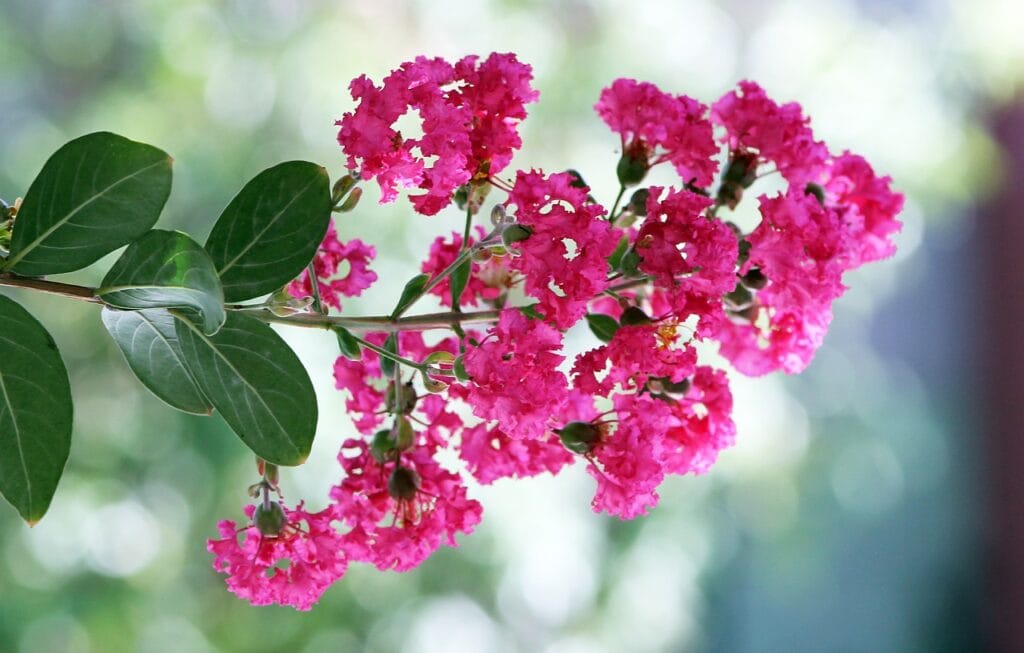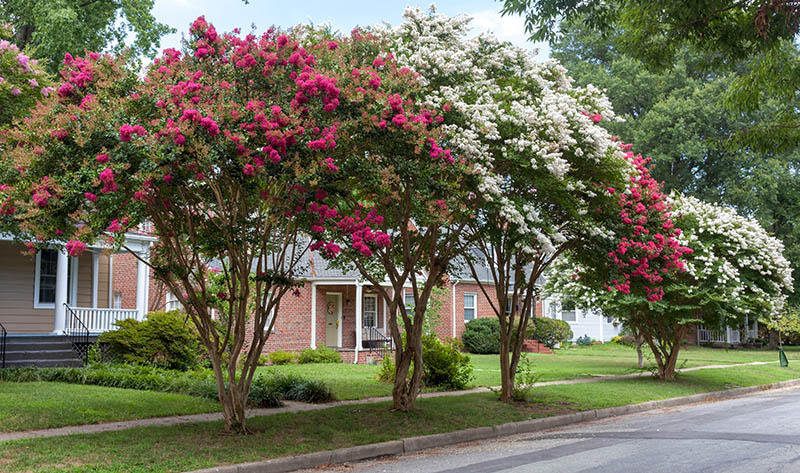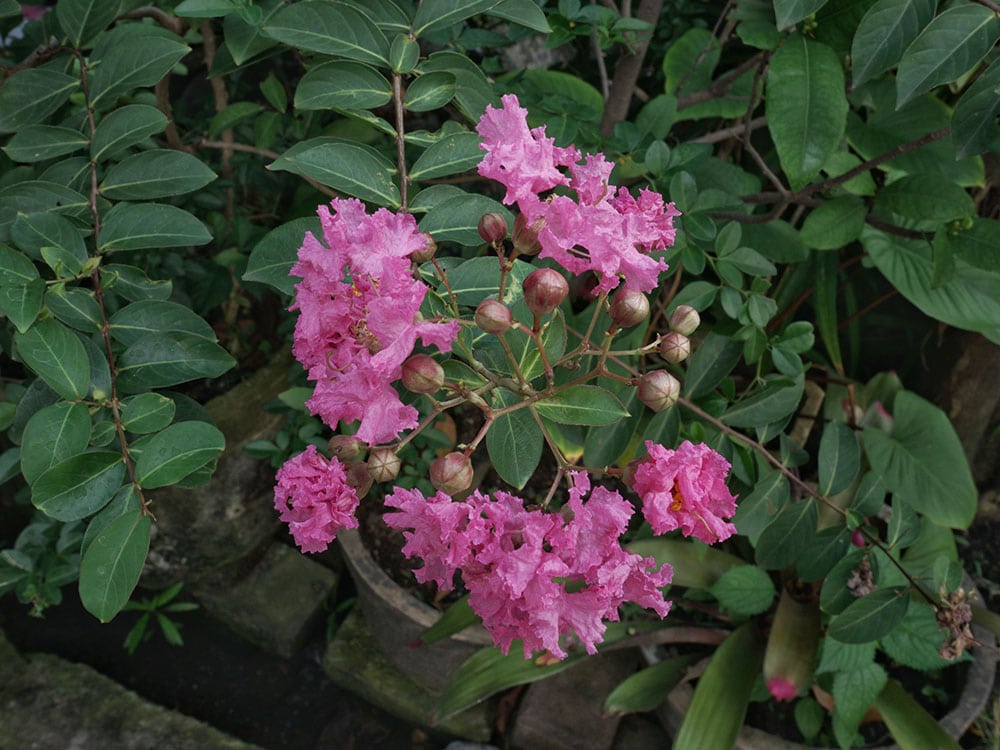10 Tips on When and How to Prune Crepe Myrtle (2025 Update)
-
Pete Ortiz
- Last updated:

The Crepe Myrtle is a small but stunning tree native to Asia and is popular among garden enthusiasts for its beautiful summer blooms.
Pruning is necessary for a few reasons. It will encourage flowers to bloom and showcase the exfoliating bark when the floral show is over, making it an all-year-round visually appealing plant in any landscape. Pruning will also help to establish its best shape and size.
In this article, we share tips on when and how to prune your Crepe Myrtle so it can provide interest through all seasons.
Before You Start
Before you begin pruning your Crepe Myrtle, consider the result you want to achieve. Less is more; you can always go back and cut down more, but you cannot replace what you have already cut. Consider how much sunlight you want to allow in, air circulation, branch spacing, and aesthetics.
Once you know how much pruning you need to do and where you will need three basic tools:
- Hand pruner to cut branches and sticks less than half an inch thick
- Loppers for cutting branches a half-inch to 1.5 inches thick
- Pruning saw to cut thicker branches
1. Know When to Prune

Pruning should be done in winter or early spring. If you’re new to pruning shrubs and trees, it’s essential to understand the difference between plants that bloom on new wood and those that bloom on old wood. Crepe Myrtle blooms on new wood and is pruned just before it emerges from dormancy or before the first signs of new growth appear.
It also lacks leaves at this time, so it is easier to see and access the branches. Pruning time may also vary depending on your USDA zone, but you will want to wait until there is no risk of frost.
2. Lay Down a Tarp

Place a tarp beneath your Crepe Myrtle to catch any debris. It can be challenging to pick up your clippings when they fall to the ground, but a tarp can make cleaning up after your pruning session a lot easier and keep infected or diseased branches off the ground.
3. Remove Suckers

Remove any unwanted suckers that have sprouted from the tree’s roots or base; this will prevent your crepe myrtle from becoming a thick, cluttered shrub. The Crepe Myrtle typically grows thickets of suckers each spring.
4. Start with the Small Branches

The small and thin branches will be the first cuts you need to make. Any branches that cross over, causing them to rub against each other, should be cut as they will eventually weaken or get damaged. Remove any dead or broken branches or branches that take away from the shape you are trying to create.
If the crape myrtle has been severely affected by powdery mildew in prior seasons, thin out congested branches within the canopy to optimize air circulation around the remaining sections of the plant.
5. Remove Larger Branches

Once you have removed the smaller branches, use the same principles to remove the bigger branches. Cut back the branches selectively around the canopy’s edge to control the plant’s overall size and shape or remove branches growing in an unfavorable direction. Removing unnecessary interior branches will also make room for more efficient sun penetration.
6. Cut the Bigger Branches using the Three Cut Method

Remember not to cut your tree to limit its height, and don’t cut too much. You can prune heavier and bigger branches using the three-cut method:
- Make your first cut a foot away from the trunk, sawing upwards through the branch until you are halfway through it.
- Make another cut about 6 inches away from the trunk, this time sawing downward from the top until you are through the branch. The stub of the branch will still be attached to the trunk.
- You will make your final cut just off the trunk of the tree, at the base of the stub, sawing from the bottom up. Make your cut outside the circular line to allow the trunk to heal.
7. Pruning for the Single Trunk Shape

A single trunk Crepe Myrtle is one of the more popular and beautiful shapes but will require more pruning each season. If you decide to go with this shape, pruning should start when it’s young, as it is hard to achieve this shape on an established tree.
Choose a single dominant trunk for the tree, prune away any others at the base, and remove any extra stems or suckers that are jutting from the ground. You’ll want all of your tree’s branching to take place in the top quarter.
8. Pruning for the Multi-Trunk Shape

Allow your Crape Myrtle to branch along the length of the stem, and follow these steps to create the multi-stem look.
- Try to prune later in the winter, preferably in February.
- Remove suckers from the bottom, rubbing and merging branches, and inward-growing branches.
- As the tree grows taller, gradually cut off all side branches from the main base.
- Never leave lone or clustered stubs, and cut off any unwanted branches before they grow too thick
9. Cut off Branch Tips and Seed Capsules

During the growth period, prune the tips of the branches that have flowers or seed capsules to encourage further bloom.
If preferred, remove seed capsules from the tips of your Crepe Myrtles branches in winter. This pruning is only for decorative value and works best on young plants or small varieties.
10. Don’t Over Prune Your Crepe Myrtle

While crepe myrtles are known for producing a lot of new growth after a fresh spring pruning, many people tend to overdo it and cut their trees down to stumps. This results in a bush of thin shoots sprouting from the ends of each unsightly stump, and because the shoots are too weak to support the flowers, the branches droop to the ground.
Before planting a variety of Crepe Myrtle, determine its mature height. If your crepe myrtle becomes too big for its current location, relocate it. Alternatively, choose a dwarf or semi-dwarf variety and only prune to maintain its natural shape.
 Mistakes to Avoid When Pruning Your Crepe Myrtle
Mistakes to Avoid When Pruning Your Crepe Myrtle
Proper cutting of the branches is essential for successful pruning because it can reduce the amount of damage, and your tree can heal faster. However, cutting too far or too close to the trunk can result in severe damage. Both these mistakes may lead to decay, and your tree will be more vulnerable to diseases and pests.
When cutting, vertical cuts should be made. Avoid cutting across the horizontal plane of a branch to prevent vertical growth. This only promotes outward growth at the cut site. It is also essential to cut with a steep slant to prevent water from sitting and being absorbed by the raw wood, which ends up in decay.
Avoid heavy pruning during their growing season, as it may starve the tree if too many leaves are removed. The tree will also lack resiliency if water is limited. Removing too many branches may also overexpose the bark and cause it to get burnt by the sun.
Using unsharpened tools can cause severe tree damage. It may result in incorrect or jagged cuts that tear the bark, causing more extensive wounds.
Conclusion
Trimming and pruning your Crepe Myrtles properly can enhance your landscape by establishing their best shape and growth and encouraging beautiful blooms. Avoid the impulse to radically prune their branches and instead thin them back and remove branches that are weak, less established, or dead.
You’ll be left with a happy and healthy shrub or tree with consistent, solid growth and a spectacular floral show. If you take care of your crepe myrtle trees, you will be rewarded with healthy and attractive trees to beautify your landscape.
Featured Image Credit: Zoya El, Shutterstock
Contents


 Mistakes to Avoid When Pruning Your Crepe Myrtle
Mistakes to Avoid When Pruning Your Crepe Myrtle